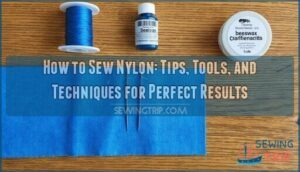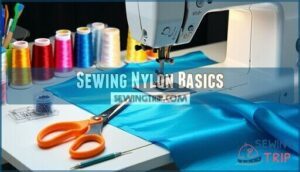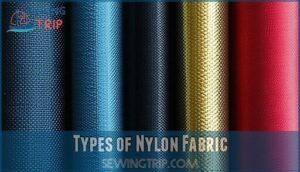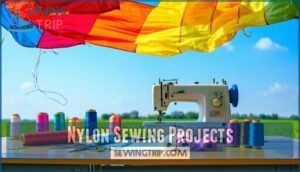This site is supported by our readers. We may earn a commission, at no cost to you, if you purchase through links.
 To sew nylon, you’ll need a fine sharp needle (size 60/8 or 70/10) and polyester thread.
To sew nylon, you’ll need a fine sharp needle (size 60/8 or 70/10) and polyester thread.
Use tissue paper under the fabric to prevent it from slipping. Set your machine to a small stitch length (1.5-2mm) and reduce presser foot pressure. Pin within seam allowances to avoid holes.
For hand sewing, try a microtex needle and beeswax-coated thread. Always test on scraps first.
Seams can be sealed with seam sealant for waterproofing. The right tools make all the difference—even experienced sewers know that taming this slippery fabric is a challenge worth mastering for durable, professional results.
Table Of Contents
Key Takeaways
- You’ll need a fine sharp needle (size 70/10 for lightweight nylon or size 18 for webbing) and polyester thread for best results when sewing nylon.
- You should stabilize slippery nylon fabric by using tissue paper underneath, reducing presser foot pressure, and using painter’s tape instead of pins to avoid permanent holes.
- You’ll want to set your machine to a small stitch length (1.5-2mm or 8-10 stitches per inch) to prevent perforation while maintaining seam strength.
- You can reinforce weight-bearing seams with topstitching or felled seams, and apply seam sealant for waterproofing to ensure your nylon projects are durable and weather-resistant.
Sewing Nylon Basics
Sewing nylon starts with understanding its unique properties, like durability and resistance to wear.
You’ll need the right tools and techniques to manage its slippery texture and guarantee strong, neat seams.
History of Ripstop Nylon
Ripstop nylon, a DuPont invention from the 1930s, revolutionized textiles with its tear-resistant design.
Initially crafted for hot air balloons, it found military applications during World War II, replacing silk in parachutes.
Post-war, its popularity soared, debuting in stockings and outdoor gear.
Today, this nylon fabric thrives in modern expansion, blending durability with versatility across industries. For heavy-duty projects, consider using a walking foot machine.
- Military Origins: Parachutes and combat gear.
- Stocking Debut: Affordable, durable fashion.
- Post-War Popularity: Outdoor and tactical uses.
Properties of Ripstop Nylon Fabric
This nylon fabric stands out because of its lightweight durability and distinct crosshatch pattern, which reinforces tear resistance.
Its water repellency guarantees it can handle tough weather while staying versatile.
Ripstop nylon’s fabric properties make it reliable for projects needing long-lasting strength, with its exceptional fabric durability being a key advantage.
Whether sewing nylon into gear or apparel, you’ll appreciate its unique design and long-lasting strength.
Applications of Ripstop Nylon
Lightweight and tough, Ripstop nylon excels across projects.
Its weather resistance makes Kite Design a breeze, while Sail Durability and Banner Strength benefit from its weave.
Jacket Foldability shines with its compact nature. Parachute Airflow? Perfectly balanced.
When sewing nylon fabric for jackets, bags, or nylon fabric projects, its versatility guarantees reliability and innovation in every stitch!
How to Sew Nylon
Getting the hang of sewing nylon fabric can feel tricky, but with the right approach, it’s a breeze.
First, make sure to properly prepare your tools. Choose a Universal 70/10 needle for thinner nylon or size 18 for thicker materials. The best thread for nylon is a commercial-quality nylon or polyester thread—avoid cotton, as it weakens seams over time.
For sewing heavier materials, consider using a walking foot machine. Keep stitch length around 8-10 per inch to prevent perforation.
Maintaining fabric control is essential. Use painters tape instead of pins to hold seams, as pinholes can damage the fabric. For seam finishes, consider French seams for durability and a clean look.
- Start slow: Test on scraps to get comfortable.
- Stay precise: Use sharp scissors for clean cuts.
- Reinforce strength: Topstitch weight-bearing seams.
Choosing Nylon Fabric
When choosing nylon fabric, focus on its type, weight, and thickness to match your project needs. Consider options like ripstop for durability or flame-retardant varieties for added safety.
Focus on type, weight, and thickness—ripstop nylon ensures durability, while flame-retardant options add safety for specialized projects.
Types of Nylon Fabric
When choosing fabric for nylon sewing, consider Nylon Denier, which measures thickness and strength.
Popular Nylon Variants include textured nylon for its durability and coated nylon for water resistance. Ripstop nylon’s crosshatch pattern adds tear resistance.
Nylon Finishes, like waterproofing or flame retardants, enhance functionality. Nylon 6,6 is a common type known for its strength and versatility.
Understanding nylon fabric properties guarantees smart nylon fabric selection for your specific project.
Weight and Thickness Considerations
When working with nylon fabric, fabric weight and thickness dictate your needle selection, thread type, and sewing machine settings.
Lightweight fabric suits delicate projects but may need careful handling for seam strength.
For heavier thickness applications, use a suitable needle like 70/10, paired with durable nylon thread. Adjusting tension guarantees smooth stitching without damaging the fabric’s structure.
Flame Retardant and Zero Porosity Options
When sewing nylon fabric, consider flame retardant and zero porosity options for projects requiring safety and durability.
Keep these in mind:
- Flame Retardancy Standards: Essential for public spaces or industrial applications.
- Porosity Measurement: Zero porosity fabrics prevent air and water passage.
- Safety Regulations: Always align with project-specific legal requirements.
- Cost Analysis: Balance features with your budget needs.
Choose carefully!
Sewing Techniques for Nylon
To sew nylon successfully, start with the right tools like sharp needles and polyester or nylon thread to avoid damaging the fabric.
Use proper techniques such as adjusting stitch length and reinforcing seams to guarantee a clean, durable finish.
Essential Tools for Sewing Nylon
Why does a sharp needle matter? For nylon sewing, pick a Universal 70/10 needle to avoid snags.
Use nylon or polyester thread for strength.
Sharp cutting tools, like fabric scissors, guarantee clean edges on nylon fabric.
A sewing machine with adjustable stitch length is key—set it to 8-10 stitches per inch.
Accurate marking requires tailor’s chalk for precision.
Seam management tools, like pins or clips, help maintain alignment.
Handling Thin and Slippery Fabrics
Now that you have your tools ready, let’s tackle the challenge of thin, slippery fabrics.
Nylon can slide around like butter on a hot pan.
To control fabric slipping, use painter’s tape instead of pins.
Many crafters find painters tape useful for various projects.
When sewing nylon for beginners, stretch the fabric gently with one hand behind and one ahead of the presser foot.
Choose the right needle size (70/10) and stitch length (8-10 per inch) to avoid melting or perforation.
Reinforcing Weight-Bearing Seams
While slippery fabrics present challenges, your seams need extra attention where weight or stress will be applied.
For reinforcing weight-bearing seams when sewing nylon, add a topstitch 1/8 inch from the original seam.
Felled seams provide maximum fabric reinforcement for backpack straps or tent corners.
Maintain proper stitch density—8-10 stitches per inch offers the ideal balance between strength and avoiding fabric perforation that can lead to tears, ensuring maximum fabric reinforcement.
Nylon Sewing Projects
You’ll find endless possibilities for your nylon fabric, from lightweight outdoor gear to durable everyday items.
With the right techniques, you can create beautiful kites, water-resistant jackets, sturdy banners, or even functional parachutes using your new sewing skills.
Sewing Nylon Webbing
Now that you’ve mastered handling slippery fabrics, let’s tackle nylon webbing. Working with this sturdy material requires a size 18 needle and doubled nylon thread.
Knowing the appropriate thread dimensions is essential for strong seams.
For hand sewing nylon webbing, use a thimble to protect your fingers and needle-nose pliers to pull the thread through. Start your stitches near the edge and secure with an overhand knot for maximum durability.
Creating Banners and Flags
After working with nylon webbing, you might want to try your hand at banners and flags. Ripstop nylon fabric is perfect for these projects due to its strength and lightweight nature.
When creating banners and flags, follow these steps:
- Select color-fast nylon fabric that won’t fade in sunlight
- Double-hem all edges for wind resistance
- Reinforce corners with extra stitching
- Create sturdy flagpole attachment points using grommets
Making Jackets and Parachutes
Outdoor adventures require specialized gear. When making nylon jackets and parachutes, focus on these key considerations:
| Project Type | Seam Strength | Special Techniques |
|---|---|---|
| Jackets | Double stitching | Weatherproofing seams |
| Parachutes | Triple reinforcement | Deployment mechanism attachment |
| Harnesses | Box stitching | Safety reinforcement points |
For jacket weatherproofing, seal all seams. With parachutes, stitch reinforcement is critical – lives depend on your sewing skills.
Many sewers prefer to use specific jacket materials for durability.
Sewing Kites and Sails
When sewing kites and sails with ripstop nylon, you’ll need to adjust your thread tension to prevent puckering.
The plain seam works best for these weather-resistant projects.
- Use lower top and bottom tensions than normal sewing
- Cut fabric with sharp scissors or a rotary cutter for clean edges
- Apply painter’s tape instead of pins to hold seams in place
- Reinforce stress points for better kite aerodynamics and sail construction
Frequently Asked Questions (FAQs)
Can you sew nylon with a regular sewing machine?
Like a needle through cloth, you can definitely use your regular sewing machine for nylon.
You’ll just need a sharp universal 70/10 needle and polyester thread.
Adjust stitch length to 8-10 per inch.
Is nylon fabric hard to sew?
Nylon can be challenging due to its slippery nature.
You’ll need a sharp needle (size 70/10), polyester thread, and patience.
Using painter’s tape instead of pins helps manage the fabric’s tendency to slip.
What stitch is best for nylon?
For nylon fabric, straight stitches (8-10 per inch) work best. You’ll want polyester or nylon thread with a universal 70/10 needle. For stronger seams, add reinforced topstitching where durability matters most.
What needle to sew nylon?
For successful nylon sewing, you’ll need a sharp, fine needle. Use Universal size 70/10 for lightweight ripstop or size 80/12 for standard nylon. Switch to size 18 when working with webbing.
What is the best way to prevent fraying when sewing nylon?
To prevent fraying when sewing nylon, seal raw edges with a hot knife or lighter, apply fray check solution, or use pinking shears.
You’ll also want to sew with proper seam techniques like French seams.
Is it possible to dye nylon fabric?
Yes, you can dye nylon fabric effectively with acid dyes or disperse dyes.
For best results, use hot water and vinegar as a mordant.
The synthetic fibers absorb color well when properly prepared.
What type of needle should be used to sew nylon?
For sewing nylon, you’ll need a sharp, fine Universal 70/10 needle. When working with nylon webbing, switch to a size 18 needle. Always use new needles to prevent snagging the slippery fabric.
How do I join two pieces of nylon fabric together?
To join nylon pieces, place them right sides together and use a straight stitch with 8-10 stitches per inch.
You’ll need a sharp 70/10 needle and polyester thread.
Secure with painter’s tape instead of pins.
What is the best way to store and preserve nylon fabric?
Like a treasure awaiting discovery, your nylon fabric will last longer when you store it in a cool, dark place away from sunlight.
Roll it rather than fold to prevent creases and cover with acid-free paper.
Can nylon fabric be ironed safely?
You can iron nylon safely by using the lowest heat setting and placing a pressing cloth between the iron and fabric.
Always keep the iron moving to prevent melting or scorching your material.
Conclusion
Mastering how to sew nylon is like taming a wild horse—challenging but rewarding.
With the right tools and techniques, you’ll create durable, professional projects that withstand the elements.
Remember to use fine needles, reduce your stitch length, and stabilize with tissue paper.
Don’t forget seam sealant for waterproofing when needed.
Whether you’re making outdoor gear or simple repairs, your nylon-sewing skills will serve you well for years to come, and practice makes perfect!












